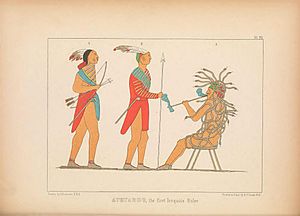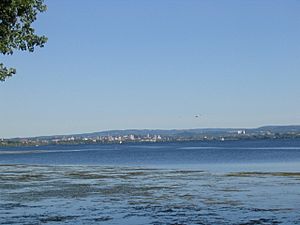Tadodaho facts for kids
Tadodaho was an important Native American leader. He was a Hoyenah (which means chief or sachem) of the Onondaga nation. This was before the Deganawidah and Hiawatha helped create the Iroquois League. Old stories say he was very powerful and scary. But he was convinced to join the group of the Five Nations.
His name, Tadodaho, is now used for the chief who leads the Grand Council of the Iroquois League. This chief is always chosen from the Onondaga nation. This is because the Onondaga are known as the "keepers of the council fire." This position is very important for the Iroquois in New York State. The Iroquois, also known as the Six Nations, have had a lot of influence there for a long time.
Contents
The Legend of Tadodaho
Tadodaho was known as a strong warrior and a main chief of the Onondaga people. His name has been spelled in different ways, like Adodarhoh or Atotarho. In a book from 1883, The Iroquois Book of Rites, it says Atartaho means "entangled." Another old story from 1889 called him a "misshapen monster." Some legends say Tadodaho had messy, spiky hair that looked like snakes. They also said his body was "twisted." People believed he could hurt his enemies from far away without even seeing them.
Tadodaho ruled by making people afraid. His own people thought he was a sorcerer, someone with magic powers. He also scared other groups, like the Seneca and Cayuga nations. Tadodaho successfully led his Onondaga people in attacks against the nearby Cayuga people. He also traveled west and attacked the Seneca people.
Peace among the Haudenosaunee (another name for the Iroquois) was hard to achieve because of how much people feared Tadodaho. Deganawidah, from the Huron people, and Hiawatha, from the Onondaga, really wanted peace among all the Haudenosaunee groups. The legend says that all the other chiefs agreed to peace except for Tadodaho. He was seen as the biggest problem for the Great Law of Peace. He stopped Hiawatha's attempts to start peace talks three times.
Hiawatha's first daughter died after Tadodaho stopped the first meeting. His second daughter died after Tadodaho ruined the second meeting. People believed Tadodaho's powers caused their deaths. Hiawatha's third daughter died at the council fire during the third meeting, while Tadodaho was there.
A writer named Hewitt wrote in 1888 that Hiawatha cried, "All my children are now gone from me. They have been destroyed by Tha-do-da-ho, and he has spoiled our plans. I must now go among other people."
According to Haudenosaunee legend, Hiawatha and Deganawidah used smart plans and spiritual ways to get Tadodaho's support. Hiawatha and Deganawidah walked with chiefs from the Cayuga, Mohawk, Oneida, and Onondaga peoples to Canandaigua Lake. They sang a song called the "Peace Hymn." When they got to Canandaigua Lake, they convinced the Seneca people to join their mission for peace.
Deganawidah said he was ready to meet Tadodaho at Onondaga Lake to win him over. He said:
"We must find Tadodaho. He is the only one stopping us. His mind is twisted, and there are seven bends in his body. These must be straightened for our league to last."
Hiawatha and Deganawidah talked with Jigonhsasee, also called Mother of Nations. She told them how to convince Tadodaho. They used a special holy ceremony with medicine to calm Tadodaho and heal his mind and body. In one story, Jigonhsasee herself spoke with Tadodaho privately. Hiawatha combed the tangled parts out of Tadodaho's hair. Deganawidah massaged Tadodaho's body with special herbs and wampum (beads). He straightened the seven bends in Tadodaho's body.
After Tadodaho was healed, he allowed the Onondaga people to join the peace council. Tadodaho became part of the League of the Great Peace. He was given the important job of "firekeeper" for the group. This meant he was the chairman, or leader, of the council of nations. The final steps toward peace happened at Onondaga Lake.
The story of Tadodaho is still told in Haudenosaunee society today. The name Tadodaho now refers to the chief who leads the Onondaga council. Charles L. Henning wrote in 1902:
"...the name Tadodaho stayed with the tribe. When a man had to be the head-chief of the Onondagas, he was always called Tadodaho. The Tadodaho is the only proper man to invite people to the general council of the five nations. Because of this, he is seen as the 'fire keeper,' because the Onondagas kept the great council fire."
The Spiritual Leader Called Tadodaho
The name Tadodaho has been used for centuries by the Iroquois to mean their most important spiritual leader in New York State. This Tadodaho is the spiritual leader of the Haudenosaunee, also known as the Six Nations. These nations include the Cayuga, Mohawk, Oneida, Onondaga, Seneca, and Tuscarora people. This position is also called the "Head Chief of All the Six Nations." He leads the Grand Council of the Haudenosaunee.
The Great Council Fire of the Iroquois League is still located on the Onondaga reservation in New York today. Many Iroquois people live in Canada. Their ancestors moved there after the American Revolutionary War because they were allies of the British, who lost the war. The British government gave them some land to make up for what they lost.
The Tadodaho, along with other Native American leaders, is responsible for keeping the history of the Haudenosaunee people alive. The position of Tadodaho is for life. When the previous Tadodaho passes away, a council of chiefs from the Haudenosaunee chooses a new leader from the Onondaga people.
Modern Leaders and Challenges
In 1968, George A. Thomas was the Tadodaho. He asked for the return of 25 wampum belts that were held by the New York State Museum. Thomas explained:
"it was wrong for our grandfathers to give away the wampum. The wampum tells of old, old agreements and shares the thoughts of our grandfathers. We would like to see them. Our people would like to touch them."
An anthropologist called this disagreement "the great wampum war." It affected how the Iroquois people, the New York State Museum, and universities worked together. Thomas stressed the spiritual importance of the wampum belts. This happened during a time when Native Americans were actively working for their rights. This led to a law called NAGPRA. This law helps protect Native American cultural items and encourages museums to return important items to the nations.
On December 7, 1968, Leon Shenandoah was chosen as the next Tadodaho. In his daily life, he worked as a custodian at Syracuse University. Shenandoah believed his role had both political duties and spiritual meaning. He was against the Haudenosaunee nations getting involved in gambling businesses. He warned about the moral problems that could come with such choices. He was highly respected for his spiritual leadership. When he died in 1996, Native Americans across the United States mourned his passing. He served as Tadodaho for over 25 years. This was a time of big changes for the Iroquois and other Native American nations, who were working to regain their independence.
In 2002, Sidney Hill was chosen as the Tadodaho. He has been active in land claim cases in New York. In these cases, the Iroquois nations have asked for their lands back or for payment for lands they were forced to give up after the American Revolutionary War. Some of these land claim cases have been supported by federal courts.
In 2005, Tadodaho Hill led a group of Onondaga people to file papers in United States federal court. They claimed ownership of about 4,000 square miles (10,000 km2) in Upstate New York. This land claim included areas along Lake Ontario, from the Thousand Islands through Syracuse, to the border of Pennsylvania. It also included Onondaga Lake. Hill wanted to show his people's wish to see Onondaga Lake become healthy again.
In May 2013, Tadodaho Hill sent a letter to several Iroquois communities. He wanted to guide their relationship with the Confederacy and its old traditions. He and others have been against an agreement made by the Oneida Nation of New York on May 16, 2013. This agreement would involve the tribe putting their land into a trust, accepting New York taxes, and more New York control over their matters. This was part of a deal to allow gambling. Some, like Mohawk journalist Doug George-Kanentiio, say this tribe was not officially part of the Haudenosaunee when the Confederacy was formed.
See also
 In Spanish: Tadodaho para niños
In Spanish: Tadodaho para niños



